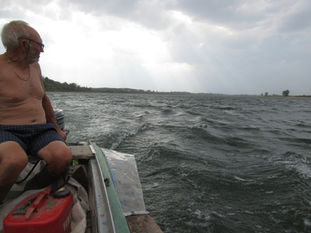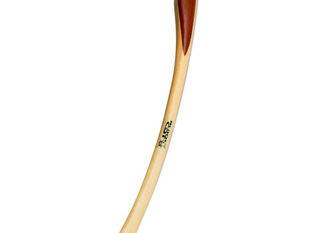
The foraging evolutionary direction taken by jackals has made them human neighbours. This in turn demanded from them adaptation to significant changes that may occur with the humans they depended on. About how they reacted to a major incident that hit the camp in June 2019, we will tell you in this story.
Life on the river-bank is rarely without some threat for more than a week. Nice, quiet days end in a thunder-storm when lightnings strike a few hundred metres from the camp, and at times even less. Winds pick up speed and then the river is fearful to look at, let alone be in rubber dinghy hauling nets out. During the hot summer of 2024 even during the night temperatures did not fall below thirty.
Another danger lurks in the forever rising and falling water-level. The optimal level when life is easy is when the water-level is between 200 and 300 cm. This is that much higher than the lowest point the river has ever fallen to at the place of measurement. There was no measuring pole at Km 727, so all figures given here are by the station in Lom, sixteen kilometres upriver (River Km. 743.3).
By Lom levels, the camp was safe at up to 600 cm. Above that, things became difficult. At 800 cm the camp would be half-submerged. Beyond that point, evacuating whatever could be saved becomes urgent. It is to be mentioned here that in April 2006 water-level in Lom had reached 912 cm. This is over nine metres above the lowest-ever point. Nearly half of the town was under water to the level of ground floors.
By the end of May, the water was at the 400 cm mark which was normal for that month – snow was still melting in the high mountains of the huge Danube basin. But then it went on rising. At lunchtime on 4 June the level was over 700 cm. My father wrote in his diary that the water was splashing at two metres from the tent.

The next day the water entered the tent. Ivo, my father’s friend from Stanevo, came in his boat with bread and chicken carcasses for the jackals. He came with his fishing-mate who made dire warnings about the level rising dangerously, that my father should pack up and leave, etc.
By 9 June, the water was at 810 cm (Lom). The big tent was flooded to half the supporting poles. The river was inside the tent. Part of the furniture, together with the cooking-range were underwater.
My father dragged up the slope whatever could be saved, beginning with the solar panel, electric generator, and related equipment. Ledges with logs and supporting pegs were made some way up the bluff-face to store luggage. A small tent which by a lucky chance I have left for him the previous summer was set up on another ledge. By 9-10 June, the situation looked like this:

What was happening with the jackals during these trying times? Their core territory below the bluff-face had shrunk to a sliver of dry ground. My father moved the bait-site some way up:

What with my father’s emergency tent moved to a new place, and the bait-site also, both were now barely three metres from each other, making use of the few dry spots remaining. The question now was: would the jackals come to eat given the very short distance between bait-site and tent?
The answer was somewhat unexpected. The first to come was not a jackal, but Badger Gosho. That was on the night of 8 June, at 21:19. On that particular night, Ivo had come again. He and my father were talking while arranging nets for night-fishing. Badger Gosho was looking their way, but wasn’t greatly alarmed:
At 23:13, almost two hours later, the first jackal tried out the new site. That was a male junior adult (2 yrs. old), by the name of Dodgy. (He was not seen in the following season of ’20, probably having moved to a new place and setting up a family of his own).
Dodgy looked around, but was not greatly worried by the camp having suddenly come so close to the bait-site. It appeared that since the river had left only a few dry spots at the foot of the bluff, the new arrangement had to be accepted for what it was.
Jackal visits continued that night as during all the following nights of the emergency situation. Which meant until 17 June when the water subsided to 612 cm. and my father was able to move back to the big tent.
The emergency arrangement had lasted for about a week: 8 – 17 June. Visits continued as said above, but were less than usual: they fell from the usual 10-12 visits a night, to as low as 2-4. Moreover, half of them were by Badger Gosho. Of the jackals themselves it was mainly the juniors who visited, as well as the breastfeeding Mother. A common presence in the recorded material was the aforementioned Dodgy, as well as a young one-year-old known as Cautious. That latter very wary character did a twigging show on the night of 10 June. That looked to be his response to the tent (with my sleeping father) being so close.
The Mother, two-year-old at the time, was more confidant. She would eat standing by the main bowl with hardly a look towards the camp barely a few metres away:
As with every litter, there would be an over-cautious youngster, as well as their opposite: an over-confident one. The Boldy of Season ’19 was caught by the camera in broad daylight, marking possibly the earliest visit of that memorable summer:

Apart from the smaller number of visits, the emergency arrangement had two other notable consequences. One was that during the entire period, there was no howling, nor indeed any other form of vocal communication. The second was the absence of after-midnight visits – a pattern broken only once on the night of 12-13 June. A possible answer to this riddle was that with the bank under water, foraging must have moved entirely over the pastures and cultivated fields in the hinterland. The family may have decided to leave down by the bait-site only the youngsters, and, naturally, the breastfeeding Mother. The youngsters were supposed to be carrying food to her, but with the much-shortened distances between all key points (den, water, food), she came down herself.
Such an absence of the senior males, as well as of chorus howling, pointed to another interesting fact: the family seemed to ignore the possibility of trespassing. This could mean, in its turn, that the main line of trespassing incursions was along the bank – which was now underwater. Trespassers, on the other hand, were more cautious of the cameras and the camp itself. Now that my father’s tent was so close to the bait-site, trespassers did not have the nerve to cross the line. So, the family was right to decide that since the camp was so near, no one else would dare approach. In the end, such an attitude underlined the host status of the resident family and their trust in respect of the camp and its single inhabitant.
The flood of early June ’19 gave rise to rumours and conspiracy theories among the villagers. Alongside this excitement among the humans, animal neighbours responded to the drama in their individual ways. About all these happenings we’ll tell you in the next story.







